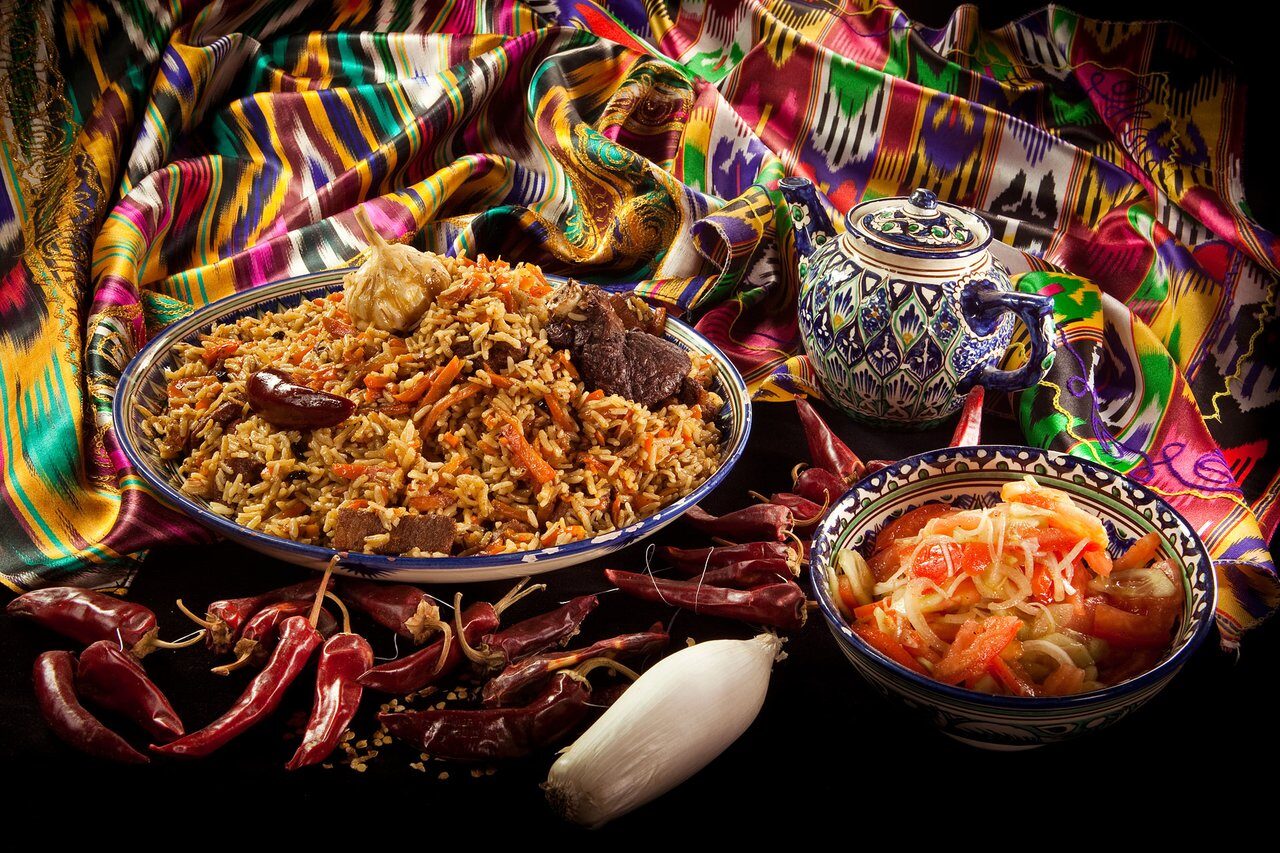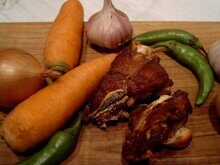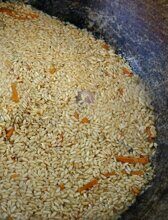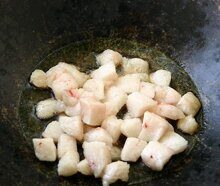Бaranina - 1 kg of pulp and 3-4 pcs. slices from the back with ribs (can be replaced with good beef or veal), fat tail fat - 300-350 g 1) (can be replaced with the same amount of vegetable oil, preferably olive oil), dev-zera rice. - 1 kg (can be replaced with good medium-grain rice), red carrots - 1 kg 2), 2-3 medium onions, 2-3 heads of garlic, 1-3 paprika (even red, even green), cumin3) salt. 4) First, cut the red, ripe, not young carrots. We will not grate it on a coarse grater, we will not grind it with a food processor, namely, we will cut it - we will take a well-sharpened knife, a board, we will be patient and cut into long strips 0.3 X 0.3 cm. Note that carrots are the Soul of Uzbek pilaf! There are many varieties of this red-sided Soul, but two requirements are mandatory - it should not be too juicy, like early spring carrots. If you don't have a pretty carrot at hand, don't be sad or upset, you just have a great reason to refuse to create pilaf!
This is how we cut carrots
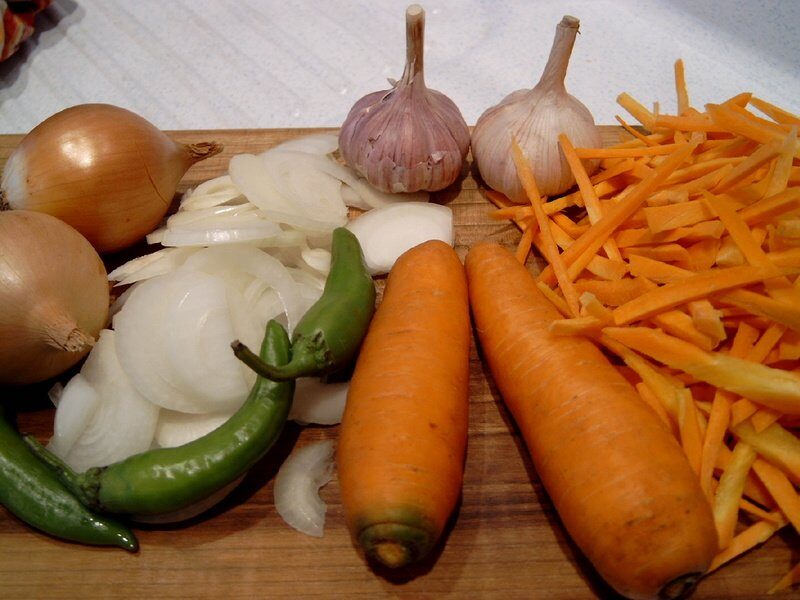
Prepare the meat: cut it into 1.5-centimeter cubes, set the bone aside, and sprinkle the back slices with ribs, lightly sprinkle with salt, lightly beat and set aside to marinate. 5) And if you do not have such slices, then you can use any brain bones left after cutting the meat, they, of course, are no longer pickled.
This is a good lamb for pilaf. Not too young, ripe with fat.
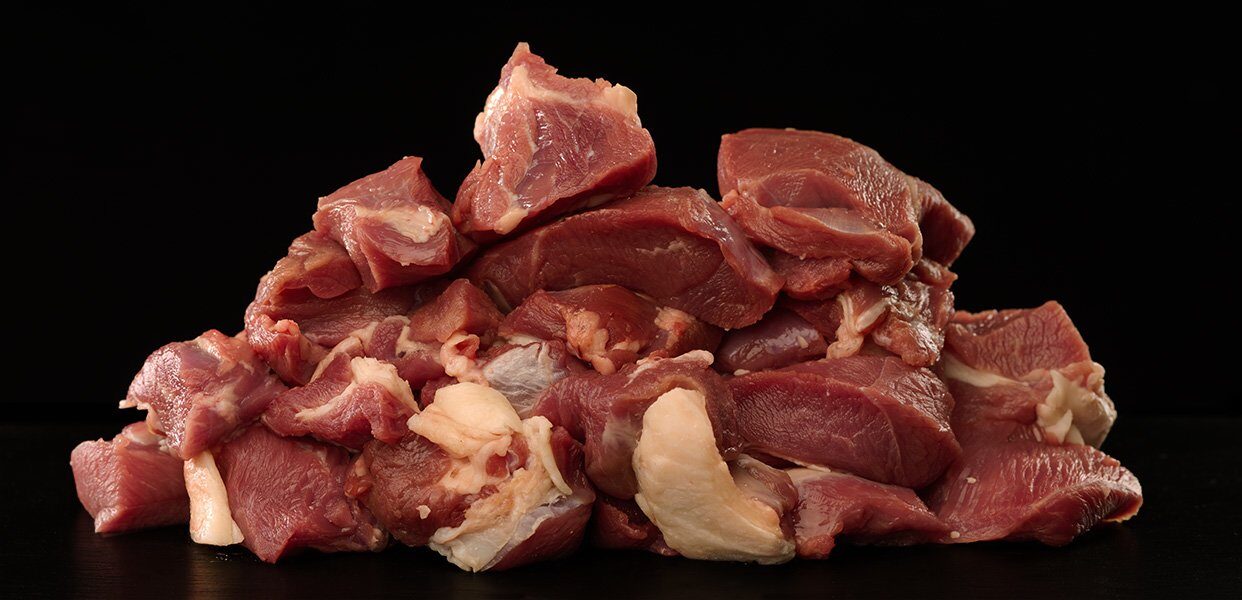
Let's go over and thoroughly rinse the rice until perfectly clear water flows out of it. Soak the rice in plenty of warm (but not hot) water. Believe me - a lot depends on it. We heat the cauldron very well. Until he warms up - a few words about him. Kazan the louder the better. This is in terms of content, but in form it is what kind of stove is in the kitchen. If the gas, it is better to have a semicircular one, if the stove is electric, then it is better to have a cauldron with a flat bottom, and if you cook in the forest or in the country on a fire, then it is better to have a spherical one with widely diverging walls. 6) Fire - at maximum. When you need to subtract - let's say! Put the lard, cut into 0.5 cm cubes, into the cauldron and melt the fat, and take out the golden fry with a slotted spoon. 7) By the way, they need to be eaten - the ritual obliges, otherwise pilaf will not work! Moreover, they go well slightly salted, with thinly chopped onions, and you can also try with pomegranate seeds and always with a flat cake. A little fire water won't hurt. But it is not worth getting carried away with this, which is certainly pleasant from any side of the recipe item. Honestly - 100 grams of vodka-brandy is still enough even for us - heroes! And no women, please! Plov, it's not a woman's business, you know. From time immemorial it was a primordially male occupation. "
All the oil was well melted from these roast, they are dry and light,
pleasantly crispy. Perfect snack!
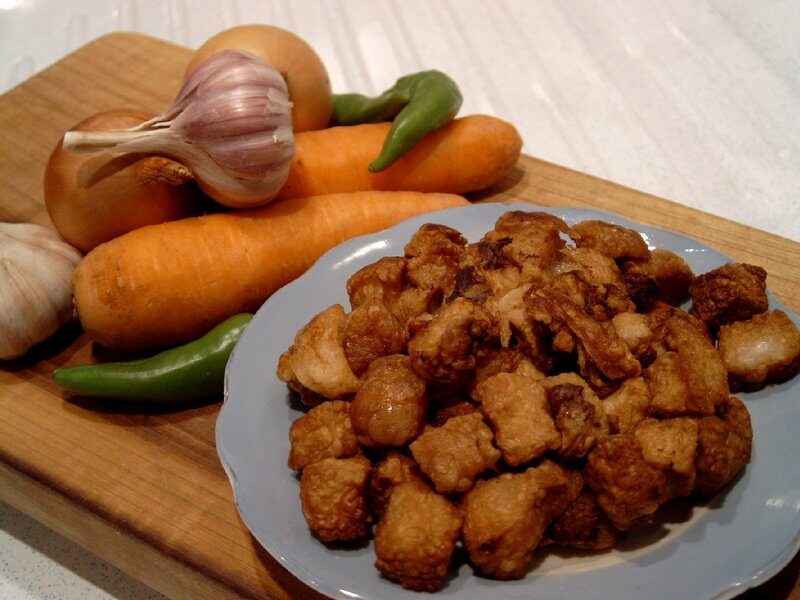
If you are cooking in oil, then pour the oil and heat it well, until a gray smoke, and then put one whole but peeled onion head in there and fry it until black - this will remove the extraneous odors of the oil. 8) Now in very hot oil (or melted lard) we lower the slices from the back. Caution - may splash and burn! They fry very quickly - they turned it over once or twice, five or six minutes, and they became a beautiful, golden brown color! And if you are cooking with a bone, then the bone should acquire a golden color. We take them out of the cauldron and put them aside.
Is it ribs, almost naked moss from a shank or a shank
ram, or generally "sugar" bones from the hip joint, that's how you need them
fry!
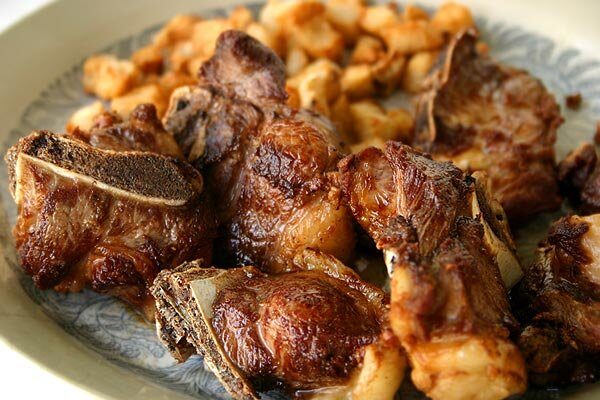
Еagain we wait for the oil to heat up and lower the onion cut into rings. Gently fry it, sometimes stirring until a red-golden color, moreover, all the water that was in the onion will almost evaporate. Do not turn down the fire yet! Now we put the meat into the cauldron and fry it, stirring occasionally, along with the onion. If water remains in the onion, then the meat will be stewed, and not fried, do you understand? Fill the carrots with an even layer. After two or three minutes, mix it around the entire perimeter of the cauldron with meat and onions. Stir gently so as not to break the carrot slices. We fry it for 10-15 minutes, by the end of frying we reduce the heat to "medium", add part of the cumin. The carrots should become soft and emit a "smell of pilaf", and if not, then this only means that they have not fried enough.
This is how we fry, over high heat.
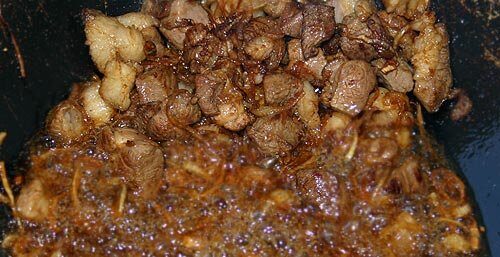
Pour in hot water so that everything is covered with water by 1-1.5 cm. We lower the whole heads of garlic and whole, without damage, chilli peppers, previously peeled from the outer husk and roots. If your pepper is fresh, juicy, then this can be done later. And if the pepper is dry and hard, then right now. 9) It doesn't matter whether you like garlic and pepper or not, you still need to put them. We also lower the slices from the back, or the bone that was fried at the beginning. After everything boils, you need to reduce the heat to "just above the very minimum." Everything should boil in an open cauldron for about forty minutes, no less.
The water should gradually boil away, and the remaining broth should become clear and have a rich red-brown color. We add fire to the "maximum", salt. About a tablespoon with a heap of salt usually goes away, but it's better to try - the broth should be slightly salted, part of the salt will take in rice. 10) If you cooked with a bone, take it out, it will not be needed anymore. So we got the environment in which rice will "bathe". It is called zirvak.
And cook on low heat, with a calm boil.

11) Thoroughly drain the water from the rice 12) and lower the rice evenly into the cauldron with a slotted spoon, leveling it over the surface. Now pour everything with about 1 liter of boiling water - carefully so as not to damage the rice layer. Here it is important not to pour too much, each time the volume of water is selected in accordance with the quality of the rice, the strength of the flame, etc. You can pour a little less and top up later than pour it all at once and spoil everything. But, the main thing is that all the rice is covered with water. We add fire to the "super maximum", it is necessary to boil as soon as possible and over the entire surface, you can even cover it with a lid for a minute! If only it boils, so that the oil floats up, and then, in the process of cooking rice and evaporating the water, it sinks through the rice, enveloping each grain of rice, then there will be pilaf, and not sticky porridge with meat! And in no case do we interfere with anything else, only we level the surface of the rice if necessary. Try rice. He shouldn't crunch his teeth, he shouldit is great to increase in volume, become almost ready and there should be no water left in the cauldron at all. Move the slotted spoon away from the edge and see - is there only oil, or is the water soaring? 13) And if the rice is still crunchy, then add a little more water (50 grams, otherwise you can easily ruin everything). If, after all, water has been poured, then it is necessary to make holes in the rice layer so that the water boils more intensively, you can move the rice layer around the edges with a slotted spoon so that it boils faster. But all this is “reanimation. - if everything was done correctly, then there is no need for it. That's when you feel that everything is going “as it should. and the rest of the water is about to evaporate, we turn down the fire to "medium-low", wait for the water to boil off completely and turn down the fire to the smallest one.
There is nothing complicated here! We see rice, we can
try, we have the opportunity to add water or, conversely, add fire, so that
rather boiled away. But the rice should look like this before closing.

14) Sprinkle the rice with lightly ground cumin and close with the tightest lid. If no lid closes the cauldron perfectly, then cover it with a large dish, it doesn't matter if there is a small gap around the edges, and then a lid as well. Wait 20-25 minutes and open. Caution - the first jets of steam are very hot. Loosening rice, we find pepper pods and garlic. Carefully so that they do not break or break, we remove them on a separate dish. Mix everything thoroughly, shaking the rice. If we come across slices of the back, we will also put them aside for a separate dish. We spread the pilaf on a round large dish with a slide, and put the garlic at the very top, decorate everything with pepper pods and slices of the back and - carried it to the table !!!
Leftover rice and other products from the table are better, of course,
remove :)))
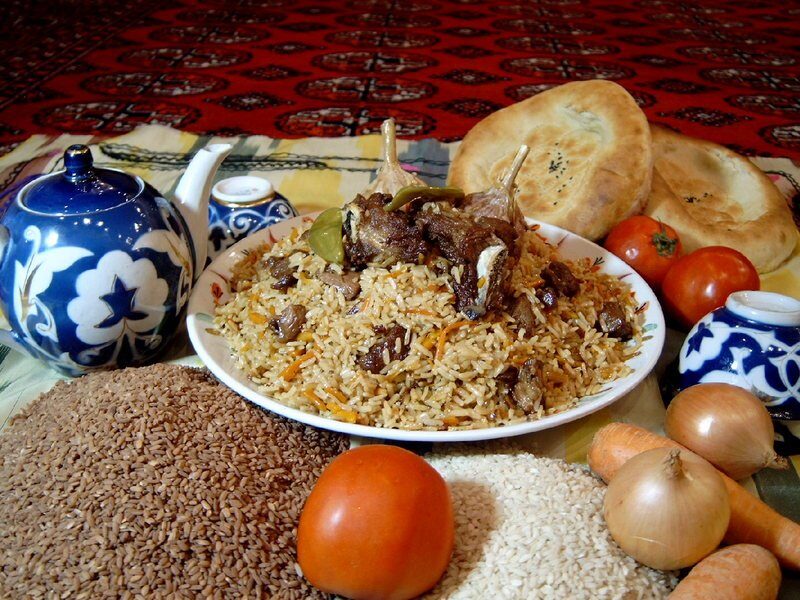
Pilaf is eaten with spoons. Better with your hands. But not with a fork - eating pilaf with a fork - it's like feeling a woman with tweezers! 15) And everything will be exactly according to etiquette if it is eaten directly from this large common dish. In the process, if anyone likes spicy, break off a piece of pepper and squeeze the contents right onto the rice in front of him. The garlic turns out to be unexpectedly tasty, we break it into cloves when it cools slightly, and the contents of the cloves are squeezed onto the rice - this will support your appetite when it seems to you for the first time that you are already full! After pilaf, we no longer drink any alcoholic beverages, no refreshing soda 16) during meals, but only hot tea - green, of course!
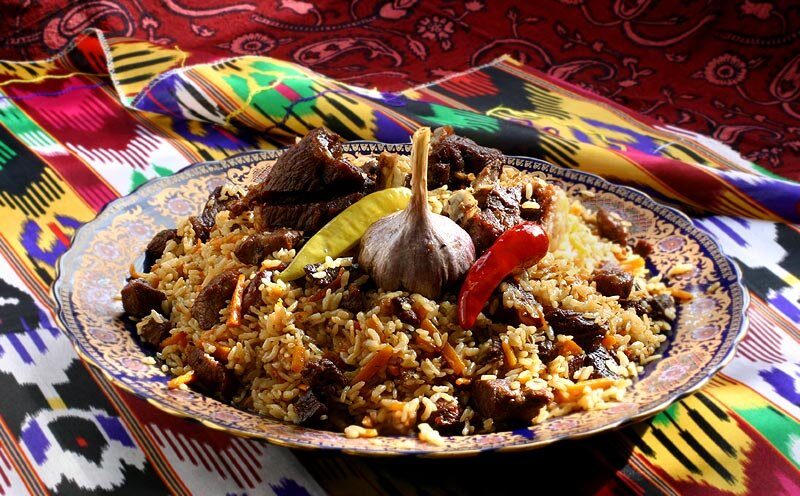
Я сколько готовлю, сколько рецептов пишу, а о весе исходных продуктов если и говорю, то вся как-тот так - на глазок.Интересно ли привести рецепт реально приготовленного с граммами?
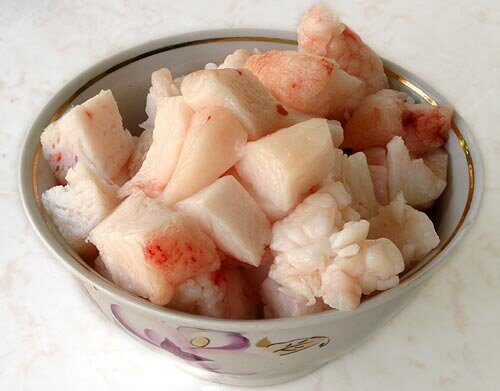
The fat tail fat - you will laugh - I cut ... exactly 454 grams. I cut it and then weighed it :)
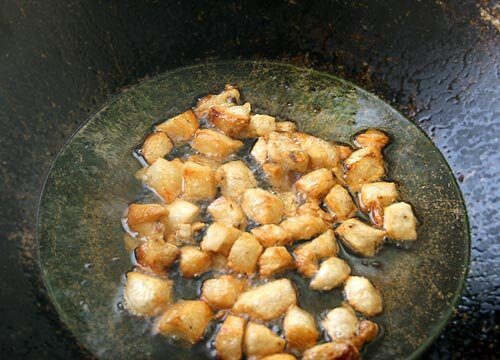
Remember, I told you that, according to the precepts of the elders, fat, while it is being melted in a cauldron, is forbidden to interfere? That's the same.
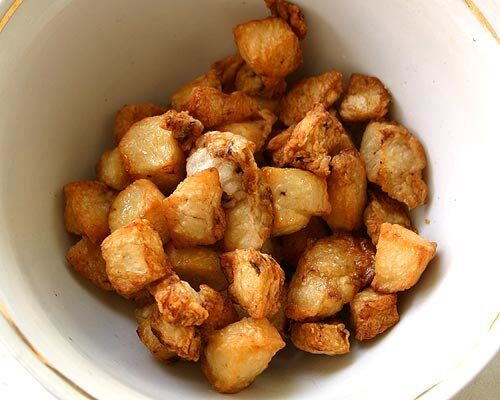
We'll just turn it over once, that's all.
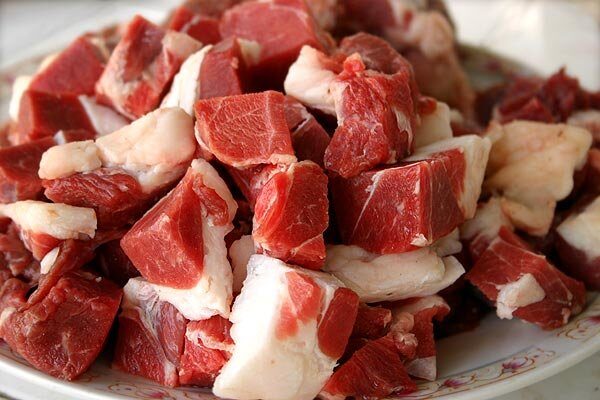
Because the fries from properly melted lard are obtained like this. And their weight is exactly 60 grams.
It would be possible to squeeze-drain a little more, there would be 50 left.I took meat, as it turned out, 1 kg 650 grams. About 650 grams of that amount, which ...

... We fry from the very beginning! Like this.
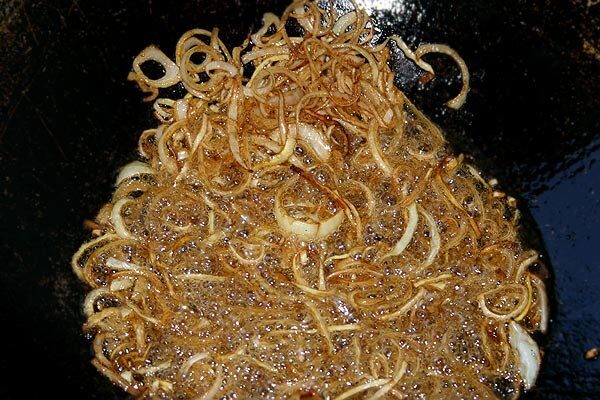
Well, and then onion-shmuk there ... 200 grams, by the way. Fry like this, no longer!

Then the meat, cut into pieces. This is how it will be fried and that's enough.
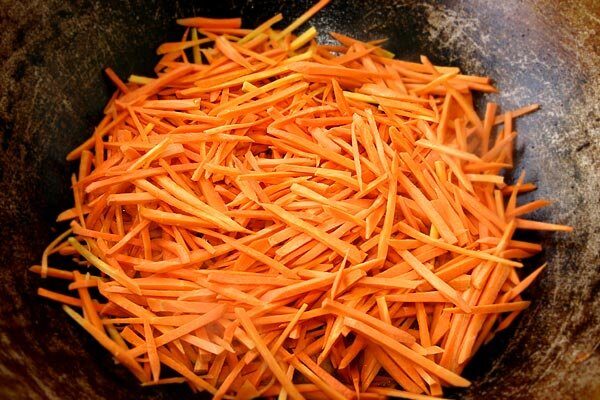
The carrots were taken by eye. Cleaned and cut, it turned out ... 960 grams!
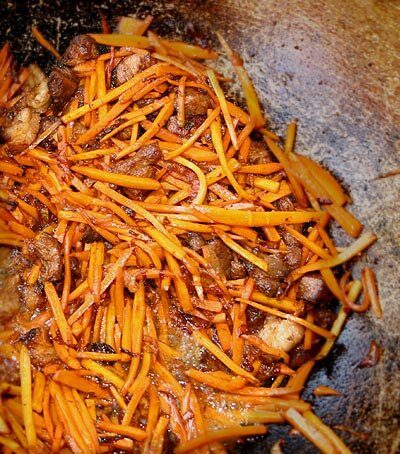 Fried, sprinkled with cumin ...
Fried, sprinkled with cumin ...
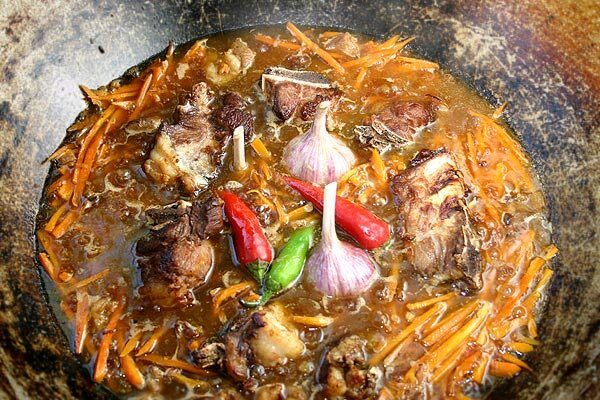
Poured boiling water. Dropped the pepper and garlic.
And for 1 hour 20 minutes. In the last 20 minutes, I salted with two tablespoons of coarse salt, scooped up the salt.
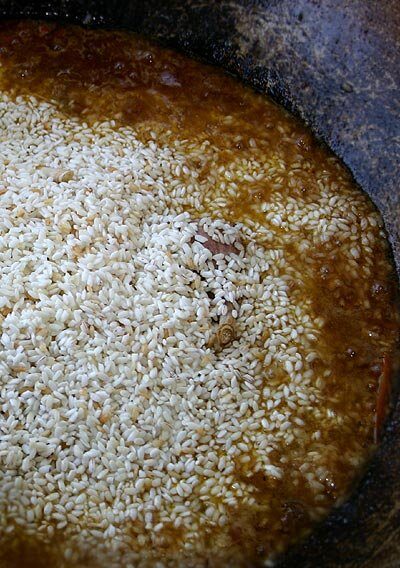 And they began to dip rice into the zirvak. And with rice in general, a funny story came out! Our home measure is a bowl of rice. Someone can measure it with glasses, someone with a cup, and others with a beaker. But it turned out that our standard amount - five bowls - is exactly one kilogram! Soaked him for two hours. After soaking, the same rice began to weigh 2 kilograms! Okay, not two. 1 kg 960 grams. But this is good rice, keep in mind! That's why I swung so wildly with bacon! Poured, boiled away, the rice became like this. It would be interesting, of course, to take it out of the pilaf and weigh it again!
And they began to dip rice into the zirvak. And with rice in general, a funny story came out! Our home measure is a bowl of rice. Someone can measure it with glasses, someone with a cup, and others with a beaker. But it turned out that our standard amount - five bowls - is exactly one kilogram! Soaked him for two hours. After soaking, the same rice began to weigh 2 kilograms! Okay, not two. 1 kg 960 grams. But this is good rice, keep in mind! That's why I swung so wildly with bacon! Poured, boiled away, the rice became like this. It would be interesting, of course, to take it out of the pilaf and weigh it again!
But you can't! It's time to close.
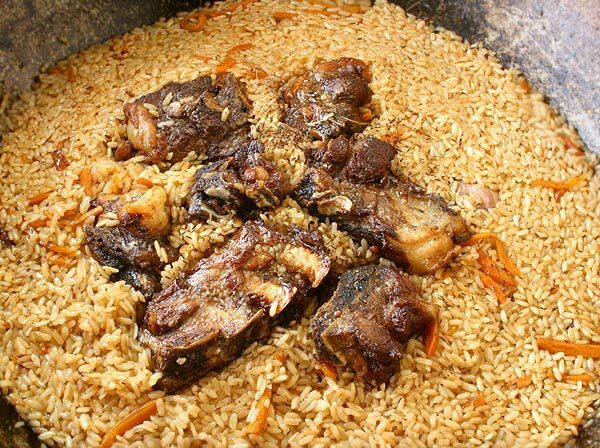
Remember those bones that I roasted in the beginning? Then they were cooked in a zirvak, and before lowering the rice, I took them out. They will interfere with an even boil, therefore. But now I will lay them on top of the rice. And I will close the pilaf. For 30 minutes. The fact that then it must be mixed and served, as in the second picture, I think, does not need to be explained to anyone. What should be served to him? The mood is good, a bottle of vodka is fogged up and this salad.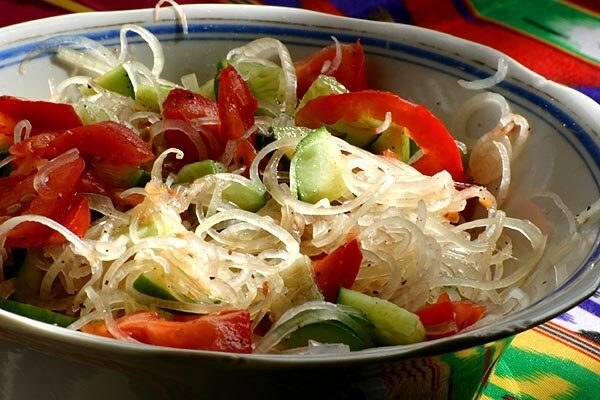
I can not help myself and show you one of the last photos of Fergana pilaf
Indeed, I won't get tired of photographing him, just as an artist won't get tired of drawing a woman he loves, and a musician playing his favorite melody)
